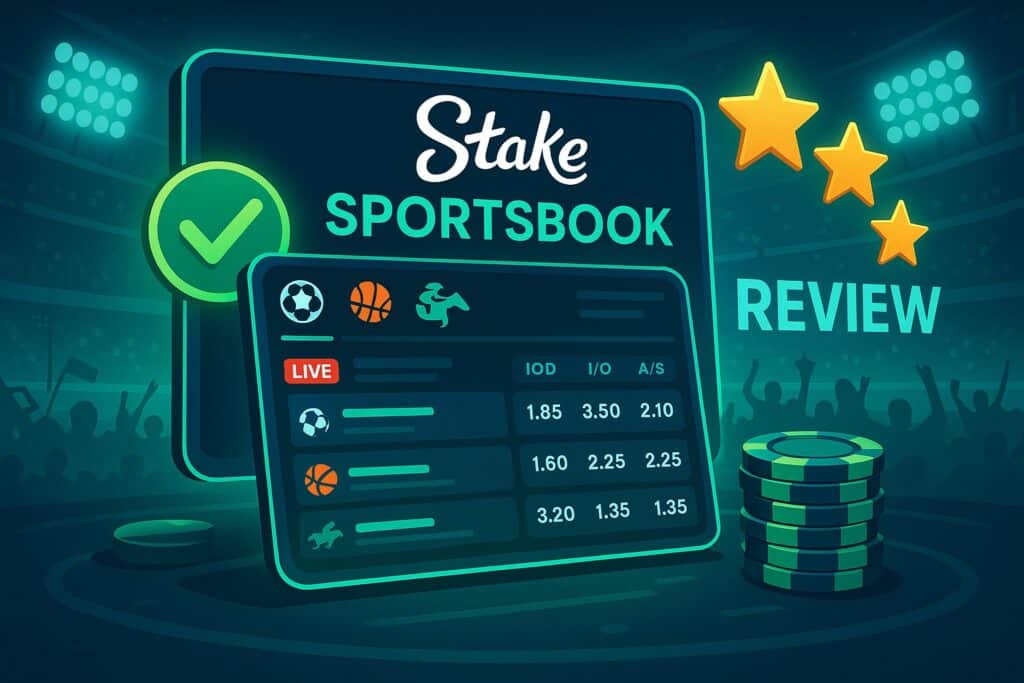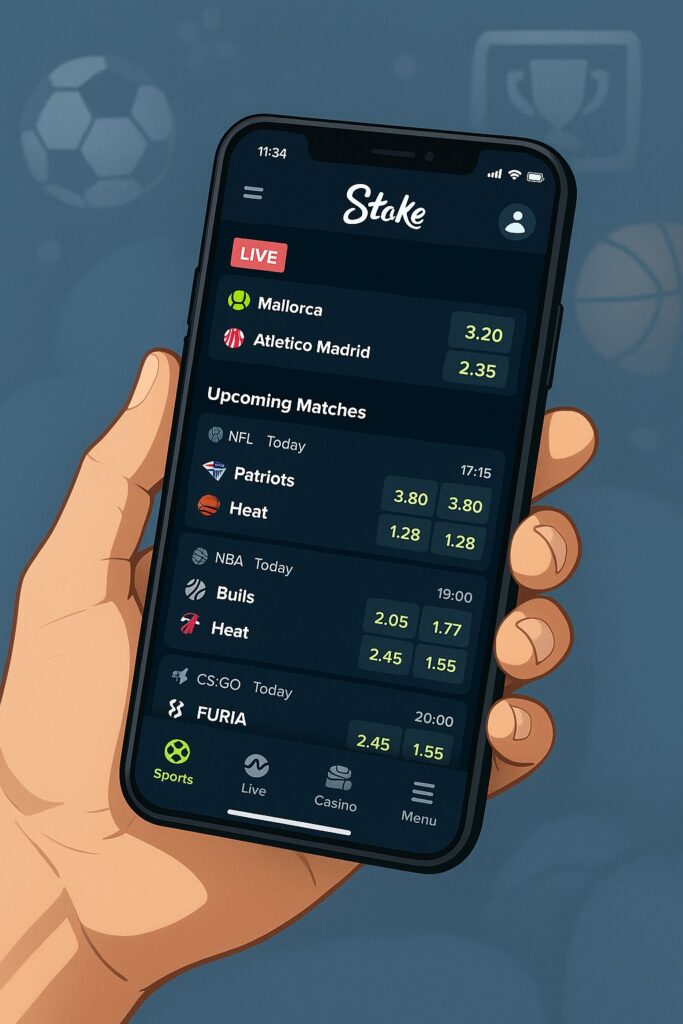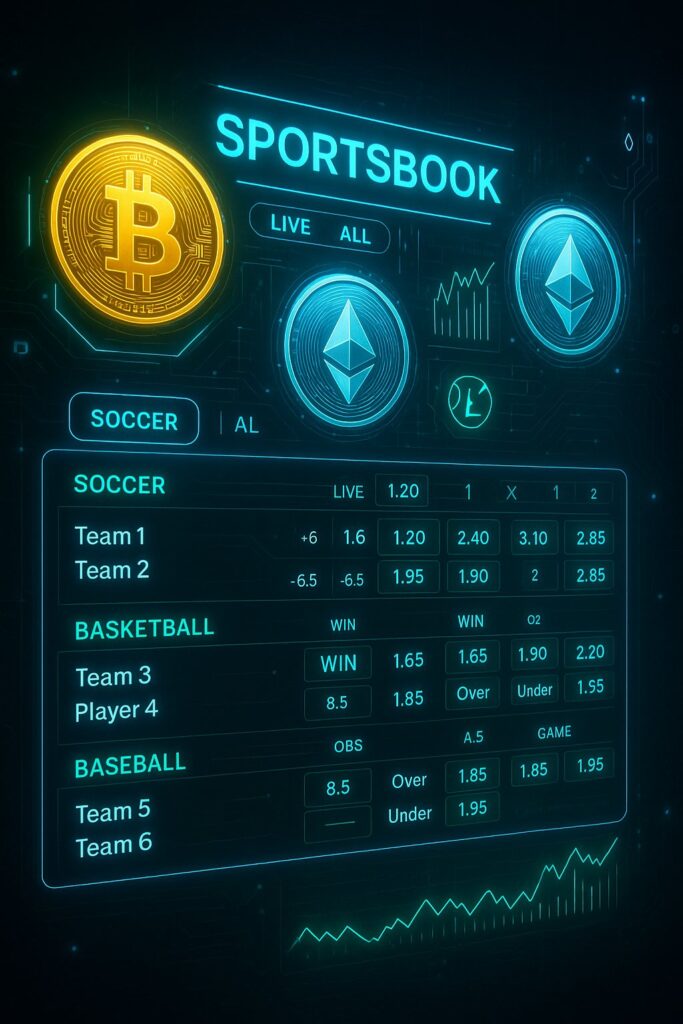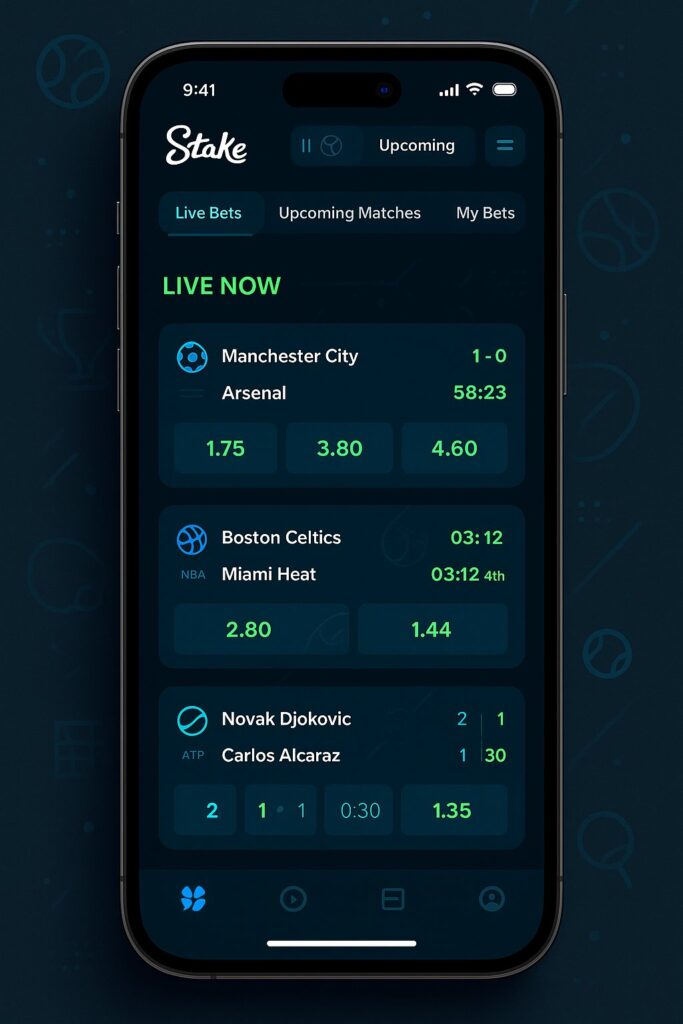Last Updated on August 28, 2025 by Martin Green
Stake Sportsbook Review January 2026: What I Like Best About Betting with Crypto at Stake
When I first tried Stake Sportsbook, I wanted to see if betting with crypto actually made a difference. It didn’t take long before I noticed how much quicker deposits and withdrawals move compared to the old-school sites. What I like best about betting with crypto at Stake is how fast and seamless the whole process feels, from placing a bet to cashing out winnings.
I also enjoy how Stake blends a crypto sportsbook with a full online casino. One minute I’m betting on live sports, and the next I’m at blackjack, roulette, or even trying Stake Originals with provably fair games. The variety keeps things interesting, and the partnerships with Pragmatic Play, Evolution Gaming, and Hacksaw Gaming give me solid live dealer games and high RTP tables.
The features built for crypto gambling keep me coming back. Stake offers in-play betting, early cash outs, and a ton of promotions without feeling clunky or dated. Whether I’m betting on sports or exploring the crypto casino, I find it easy to stay engaged and in control.
Bonuses Here
Key Takeaways
- Crypto payments make betting and withdrawals fast
- Wide mix of sports, table games, and casino features
- Useful tools and promos keep the platform engaging
- Fast crypto payouts (often instant or within hours)
- No upper deposit/withdrawal limits (supports high rollers)
- Wide crypto support (20+ currencies including BTC, ETH)
- Strong sportsbook & casino combo (3,000+ games, live betting)
- Generous VIP program (15 tiers with rakeback and bonuses)
- Provably fair gaming (transparent algorithms for fairness)
- Mobile-optimized site (no app but smooth browser experience)
- Global access (available in 50+ countries, excluding restrictions)
- No traditional welcome bonus (focus on rakeback instead)
- KYC verification required (can be slow for higher tiers)
- No fiat currency support (crypto-only, limiting some users)
- No dedicated mobile app (browser-only access)
- Restricted in key markets (US, UK, Australia, etc.)
Quick Verdict (Why I Keep Coming Back)
I keep returning to Stake because it combines fast crypto payments, reliable betting features, and a constant stream of promos. The platform feels built for people who want smooth deposits, fair odds, and clear rewards without extra hoops to jump through.

60-Second Deposits, Fast Withdrawals, And Frequent Live Promos
I can fund my account in less than a minute using Bitcoin, Ethereum, or other big coins. There are no deposit limits, and withdrawals usually hit my wallet right away. Even bigger cashouts only take longer if flagged for review.
The lack of maximum withdrawal caps really makes Stake stand out. I don’t have to worry about hitting limits if I win big – that’s rare in online betting.
Promos run daily and weekly. Stuff like leaderboard races, multiplier challenges, and bonus payouts on select sports events rotate pretty often, but there’s always something going on.
Live Betting With Streams, Deep Markets, And Real VIP Value
Live betting is where Stake really shines. Odds refresh quickly, margins stay low on big sports, and I can stream plenty of events right on the site. It’s easy to follow games and place bets without bouncing between tabs.
The sportsbook covers over 40 sports and a bunch of esports titles. I’ve found niche stuff like ski jumping and water polo along with NBA, NFL, and soccer. The depth of markets lets me bet way beyond just spreads and moneylines.
The VIP program adds actual value. Even at the lower levels, I get rakeback and weekly bonuses. Higher tiers unlock daily reloads and a dedicated host. Progress depends on wagering volume, not just one deposit, so rewards scale with activity.

Who Stake Is Best For (And Who Should Skip It)
Stake fits players who want fast crypto transactions, wide betting markets, and ongoing rewards. It works for casual bettors who like promos and casino games, and for high-volume players who care about VIP perks.
It’s not the best for sharp sports bettors. If you’re consistently profitable, Stake might apply betting limits, which takes away from the sportsbook’s value.
If you prefer fiat-only payments or want strict local regulation, Stake probably isn’t for you. It’s licensed in Curaçao, which is common for crypto sites, but doesn’t give the same protections as UK or EU regulators.
For me, the speed, variety, and flexible rewards outweigh those drawbacks.
Pros & Cons At A Glance
I’ve found Stake.com has several strong features that make betting smoother and more flexible, but it’s not perfect. The platform works best for users comfortable with crypto, while folks who prefer traditional banking might feel limited.

Pros – Crypto-First Banking With Many Supported Coins
I like that Stake focuses on crypto as its main payment method. I can deposit and withdraw using Bitcoin, Ethereum, Litecoin, Dogecoin, and a handful of others. This gives me the freedom to pick the network with the lowest fees or fastest confirmations.
Transactions are usually instant, so I don’t have to wait days for money to clear. I can move funds in and out quickly, which makes managing my bankroll way easier. Unlike traditional sportsbooks, there aren’t long processing delays or sneaky banking charges.
The privacy is a bonus. Since I’m not using a bank account or credit card, my betting activity stays off my financial statements. That adds an extra layer of discretion for me.
Pros – In-Play Betting With Live Streams
One of my favorite features is watching live streams while betting in real time. Stake covers a lot of sports – soccer, basketball, tennis, esports, you name it. I can place wagers as the game unfolds, adjusting bets based on what I see right there on the screen.
The live odds update fast, which makes in-play betting more dynamic. It’s especially useful for fast-paced sports, where momentum can flip in minutes.
Having the stream and betting interface side by side means I don’t have to switch between platforms. It’s convenient and helps me make better decisions since I’m not relying on delayed score updates.
Pros – Cash Out And Bet Builder (Same Game Multi)
Stake lets me cash out early on certain bets. If I feel the game turning against me, I can settle before the final whistle and lock in part of my stake. It reduces risk and gives me more control over my outcome.
The Bet Builder tool is another feature I use a lot. I can combine multiple picks from the same match into one ticket. For example, I might bet on the winner, total goals, and a specific player to score.
This flexibility lets me create more personalized bets instead of sticking to preset markets. It also makes smaller games more fun since I can tailor the bets to my own strategy.
Pros – VIP With Rakeback And Ongoing Reloads
The VIP program at Stake stands out compared to many other sportsbooks I’ve tried. I get rakeback, which returns a small percentage of my wagers no matter the result. That adds value over time, especially if I’m betting often.
I also get reload bonuses and other ongoing rewards. These include weekly boosts, monthly bonuses, and occasional challenges that give me extra funds to play with.
The higher my VIP level, the better the perks. I’ve noticed that customer support responds faster once I hit a certain tier, which makes the experience smoother.
Cons – Country Restrictions And Strict VPN Policy
One of the biggest drawbacks is the list of restricted countries. Some regions, including the United States and parts of Europe, can’t legally access Stake. That leaves out a lot of potential players, even if they want to use crypto.
The platform also enforces a strict no-VPN policy. If I try to log in with a VPN, my account could get flagged or even suspended. That’s risky for folks who travel a lot or want to mask their location.
For me, this is a limitation because it reduces flexibility. I have to be careful about where I log in and make sure I’m accessing the site from an allowed region.
Cons – Limited Fiat Options And Occasional Market Limits
Stake is built around crypto, which works for me, but it doesn’t support traditional fiat deposits in most cases. If I want to use a debit card or bank transfer, I usually have to buy crypto first through an exchange. That adds extra steps and fees.
I’ve also noticed some markets have lower betting limits compared to bigger traditional sportsbooks. On smaller leagues or niche sports, I can’t always place higher stakes.
This might not matter for casual bettors, but sometimes it feels restrictive when I want to wager bigger amounts. The combination of crypto-only banking and market caps is worth considering before going all in.
Stake At A Glance
Stake.com operates as a crypto-first sportsbook and casino platform. I find it stands out because it combines fast transactions, wide betting markets, and a clear focus on transparency. Its background, partnerships, and user interface all play a big part in how trustworthy and easy it feels to use.
Founded, License, And Availability
Stake.com started in 2017 and Medium Rare N.V. owns it, registered in Curaçao. The site runs under a Curaçao eGaming license, which is pretty standard for crypto betting platforms. While this license isn’t as strict as some European regulators, it still gives a legal framework for international gaming.
The platform is available in most countries, but there are restrictions in places like the United States, the United Kingdom, and several parts of Europe. Instead, Stake focuses on markets where crypto betting is more widely accepted.
The site has grown fast, reaching millions of registered users worldwide. Its focus on crypto deposits and withdrawals makes it especially appealing in regions where traditional banking for betting is limited.
Key Partnerships And Trust Signals
Stake has built credibility through partnerships with major sports organizations and public figures. For example, it has sponsorship deals with Everton FC in the Premier League and the UFC. These partnerships show the brand invests heavily in visibility and legitimacy.
I value Stake’s use of provably fair gaming for its in-house casino titles. I can verify game outcomes using blockchain tech, which adds transparency.
The site also emphasizes responsible gambling. It includes tools like deposit limits and self-exclusion options, which I consider important when deciding if a sportsbook takes player protection seriously. Combined with strong community engagement, these elements help show Stake is more than just another crypto site.
Odds Formats And Interface Basics
When I place bets on Stake, I can switch between decimal, fractional, and American odds formats. This flexibility makes it convenient for users from different regions who are used to various betting styles.
The interface is clean and modern. Sports are listed on the left, while live events and promos are highlighted at the top. The bet slip is easy to use, with quick response times even during live betting.
Navigation feels smooth on both desktop and mobile. Since Stake is crypto-first, deposits and withdrawals fit right into the betting flow. I like that payouts process quickly, often within minutes, which removes one of the biggest headaches I’ve had with traditional sportsbooks.
Why I Like Betting Here (Feature Deep-Dive)
I value Stake because it combines fast crypto payments, broad betting markets, and a user-friendly interface. The site also offers strong esports coverage, live streams, and a loyalty system that actually rewards regular play.
Lightning-Fast Crypto Deposits And Withdrawals (How It Works)
I like that Stake only uses cryptocurrencies for payments. This keeps deposits and withdrawals quick and avoids the delays that usually come with banks or e-wallets.
When I deposit, I pick my wallet address, send the funds, and usually see my balance update within minutes. The process is straightforward, and I don’t need to share sensitive banking details.
Supported coins include Bitcoin, Ethereum, Litecoin, Dogecoin, and Tether (USDT). I can also use stablecoins, which help keep my balance steady against crypto price swings.
The blockchain confirms transactions automatically, so I don’t have to wait for manual approvals. This setup makes the whole process feel smooth and reliable.
Typical Cashout Speeds And Tips To Avoid Delays
Withdrawals at Stake usually process in under 10 minutes. Most of my Bitcoin and Ethereum cashouts arrive after one or two blockchain confirmations, which is way faster than fiat-based sportsbooks.
The main thing that affects speed is network congestion. If the chain gets busy, it might take longer for my withdrawal to confirm. Picking a coin with lower fees and faster block times, like Litecoin, often helps.
To avoid delays, I double-check my wallet address before submitting a request. I also make sure I meet any wagering requirements tied to bonuses. If I skip that step, the system may hold the withdrawal until I clear the conditions.
Fees, Minimums, And Maximums Explained
Stake doesn’t charge deposit fees, but I do pay small network fees for withdrawals. These depend on which coin I use. Bitcoin fees tend to be higher, while Litecoin and Dogecoin usually cost less.
The minimum withdrawal is usually $20-50 equivalent, depending on the crypto. For deposits, I can send as little as a few bucks’ worth.
If you’re a high roller, Stake lets you withdraw huge amounts. Limits change by coin, but I’ve seen single transactions in the tens of thousands. That kind of flexibility is why both casual bettors and serious players stick around.
Here’s a quick breakdown:
| Coin | Min Deposit | Min Withdrawal | Notes |
|---|---|---|---|
| Bitcoin | ~$5 | ~$20-50 | Higher network fees |
| Ethereum | ~$5 | ~$20-50 | Moderate fees |
| Litecoin | <$5 | ~$10-20 | Faster confirmations |
| USDT | ~$5 | ~$20-50 | Stable value |
Live Betting With Streams (Where To Find Them And Best Practices)
I spend a lot of time in the live betting section. Stake makes it easy to follow games with built-in streams, especially for the bigger sports and esports. The stream window is right next to the odds, so there’s no need to bounce between tabs.
Odds update fast, and I can bet mid-game without waiting around. That speed matters since live markets shift in seconds.
I keep my bet slip prepped with my usual stake amount. That way, I can grab odds before they move. I also watch the live stats panel for extra context when I’m deciding whether to back or hedge a position.
Markets And Bet Types (Majors, Props, Futures, Niche)
Stake covers more than 30 sports. I can bet on football, basketball, darts, table tennis, and even some offbeat stuff like esports cricket or smaller leagues.
Main bet types include moneyline, spreads, totals, props, and futures. Props get really detailed for top leagues like the NBA and NFL – I can wager on player stats or team milestones.
For soccer, I like markets like first goal scorer, total corners, and cards. Futures cover league winners and long-term tournaments, so I can mix quick bets with longer strategies.
Esports Coverage I Actually Use (CS2, LoL, Dota 2, More)
Esports betting keeps me coming back. Stake covers the big games: CS2, League of Legends, Dota 2, Valorant, and FIFA. Odds show up for mobile titles too, like Arena of Valor or Mobile Legends.
Each match has tons of markets. For CS2, I usually bet on map winners, round totals, and first kill. With LoL and Dota 2, I like map handicaps, total maps, and outright winners.
Major events stream in HD, so I can actually follow the action. Odds refresh quickly, which lets me react to momentum swings as they happen.
VIP And Rakeback That Actually Adds Up (Tiers, Reload Cadence)

Stake’s VIP program uses tiers. As I bet more, I climb up and unlock better rewards. Perks include reload bonuses, weekly cashback, and monthly bonuses that scale with my activity.
I really like rakeback – I get a small percentage of every wager back instantly. It doesn’t look like much at first, but if I bet regularly, it adds up.
Reloads are steady, and I can claim them daily, weekly, or monthly depending on my tier. Top VIPs get personal account managers, custom limits, and exclusive promos.
Community And UX (Chat Vibe, Promos Hub, Betslip Flow)
The chat is always buzzing, with players sharing wins or talking matches. It gives Stake a social vibe, but I’ll mute it if I need to focus.
The Promos Hub is simple to use. I check current offers, giveaways, and events without digging through menus. That way, I don’t miss time-limited deals.
The bet slip is straightforward. I can add multiple selections, switch between single and multi bets, and adjust stakes easily. The layout works on desktop and mobile, so I can place bets wherever I am.
Banking Guide
I handle all my deposits and withdrawals at Stake with crypto, so I need to know how networks, confirmations, and wallet details work. Some coins need special tags, and if I skip them, my funds won’t show up. For folks who prefer fiat, some third-party providers offer card and mobile payment options. I also take extra steps to keep my accounts and wallets safe.
Supported Networks, Confirmations, And Address Safety
When I deposit to Stake, I always check which network my coin uses. Bitcoin needs more confirmations than Litecoin or Tron, so wait times vary. Ethereum and stablecoins like USDT need the right chain – ERC-20 or TRC-20 – or the transfer just won’t work.
I copy and paste addresses straight from Stake to avoid mistakes. To be sure, I double-check the first and last few characters before sending. QR codes help cut down on errors too.
Here’s a quick look at how confirmation times differ:
| Coin/Network | Avg. Confirmations | Speed |
|---|---|---|
| Bitcoin (BTC) | 1-3 | 10-30 min |
| Litecoin (LTC) | 1-2 | 5-10 min |
| Ethereum (ETH) | 12+ | 5-15 min |
| Tron (TRX) | 1 | Instant-5 min |
Coins That Require Memo/Tag (XRP, EOS) – How To Avoid Mistakes
Some cryptos like XRP and EOS need a memo or tag with the wallet address. If I leave it out, funds won’t credit to my Stake account. The site always shows the memo or tag during the deposit process.
I make sure to copy both the address and memo before confirming my transfer. If I forget, the transaction can get stuck, and then I have to contact support. That’s a hassle I’d rather skip.
To stay organized, I keep a checklist for deposits:
- Select the right coin.
- Copy the address and memo/tag.
- Double-check both before sending.
This routine saves me from headaches and lost funds.
Fiat On-Ramps (Cards, Apple/Google Pay) Via Providers
Even though Stake is crypto-only, I can buy coins with fiat using services like MoonPay. These let me use debit or credit cards, Apple Pay, or Google Pay. After I buy, the crypto lands straight in my Stake wallet.
In Canada, I sometimes see Interac as an option through certain partners. That makes funding my account super easy, no separate exchange needed.
Fees depend on the provider and payment method. Cards usually cost more, Interac is often cheaper. I always compare the total before I pull the trigger.
Security Best Practices For Crypto Bettors
Since I’m betting with crypto, I take security seriously. I set up two-factor authentication (2FA) on my Stake account and email. That adds a second step for logging in or withdrawing.
I keep most of my coins in a hardware wallet and only send what I plan to use. So, even if someone hacks my Stake account, the rest of my funds stay safe.
When I copy addresses, I check for clipboard hijacking by comparing the pasted address to the original. I avoid public Wi-Fi when making transactions too.
These steps take a few extra minutes, but they really help keep my funds safe.
Supported Cryptocurrencies At Stake
Stake takes a wide range of cryptocurrencies for deposits and withdrawals, so I get flexibility in managing my balance. I can use major coins like Bitcoin or Ethereum, or stick with stablecoins if I want to dodge price swings.
How I Choose Which Coin To Deposit With (Stablecoins Vs Majors)
When I deposit with Bitcoin (BTC) or Ethereum (ETH), I’m using the most recognized assets. They’re supported everywhere, but fees and transaction times change depending on network congestion.
For smoother transfers, I usually go with Litecoin (LTC), Tron (TRX), or Ripple (XRP) since they confirm faster and cost less. These are my picks when I want quick deposits for live betting.
Stablecoins like Tether (USDT) or USD Coin (USDC) help me keep my balance steady. I don’t worry about value drops while waiting to bet. This is handy when I want to hold funds on the site without the volatility.
Stake supports over 20 cryptos, so I can match my choice to my betting style. If I want stability, I use a stablecoin. If I want long-term upside, I’ll pick BTC or ETH. That flexibility makes bankroll management a lot easier.
Per-Coin Notes (One Section Per Coin)
I use different coins at Stake depending on what I’m after. Some are faster, others save me on fees, and a few are just plain easy because of exchange support. Each coin has trade-offs, so I pick based on liquidity, speed, and cost.

BTC (Bitcoin) – Liquidity, Confirmations, Why I Use It
I still like Bitcoin for bigger deposits because it’s got the most liquidity. Every exchange supports BTC, and it’s easy to swap in and out of fiat.
The downside is speed. A typical transaction takes 10 to 30 minutes, depending on congestion. Stake waits for a few confirmations before crediting funds, so BTC isn’t the fastest.
For me, Bitcoin’s reliability wins out. I use it when I want to move bigger sums safely, and I don’t mind waiting a bit longer compared to faster coins.
ETH (Ethereum) – Speed Vs Gas; Good Exchange Access
Ethereum is quicker than Bitcoin, but gas fees can spike when the network’s busy. I’ve paid from a few bucks to over $20 for one transfer, which is kind of wild.
The upside is accessibility. ETH is on almost every major exchange, and I can easily swap ERC-20 tokens into it. That’s handy if I’m already holding assets on Ethereum.
When gas is cheap, ETH feels like a good mix of speed and convenience. If fees jump, I’d rather use stablecoins on cheaper networks.
LTC (Litecoin) – Low Fees And Quick Confirmations
Litecoin is one of my go-to coins for fast deposits. Transactions usually confirm in a few minutes, and fees are barely noticeable compared to BTC or ETH.
It’s widely supported by exchanges, so I can move LTC in and out without hassle. The network is solid, and I haven’t had an issue with failed transfers.
I use Litecoin for medium deposits when I want a sweet spot of speed, low cost, and reliability. It’s practical and doesn’t have the wild swings of smaller altcoins.
BCH (Bitcoin Cash) – Low-Fee Alternative To BTC
Bitcoin Cash works a lot like Bitcoin but with cheaper transaction fees. Transfers are usually faster too, since the network isn’t as congested.
The main drawback is liquidity. Not every exchange supports BCH as widely as BTC or ETH. Sometimes I need an extra step to turn it back into fiat.
I use BCH when I want the feel of Bitcoin without paying higher fees. For moderate deposits, it’s a good compromise between cost and speed.
DOGE (Dogecoin) – Cheap Network For Casual Top-Ups
Dogecoin is surprisingly useful for small deposits. Fees are very low, and transfers confirm quickly. That makes it ideal for topping up my account when I don’t want to spend much.
The coin’s value can swing a lot, but since I only use it for short-term transfers, that doesn’t affect me much. Liquidity is good because most exchanges list DOGE.
I treat Dogecoin as a casual funding option. It’s not what I use for large balances, but for quick and cheap transfers, it works well.
TRX (Tron) – Very Low Fees And Fast Transfers
Tron is one of the cheapest networks I use. Fees are close to zero, and transactions settle in under a minute. This makes it efficient for frequent deposits.
Many stablecoins also run on Tron (TRC-20), so I often use TRX for low-cost stable transfers. Exchange support is strong, which makes it easy to move funds.
For me, Tron is one of the most practical coins at Stake. It combines speed, cost efficiency, and solid availability.
SOL (Solana) – High Throughput And Near-Instant Finality
Solana is one of the fastest networks I’ve used. Transfers usually confirm in seconds, and fees are extremely low. That makes it excellent for quick deposits.
The risk is occasional network downtime. Solana has had outages in the past, so I don’t rely on it for very large transfers. Still, for speed, it’s hard to beat.
I use SOL when I want near-instant funding. It’s especially useful for smaller deposits where I don’t want to wait.
MATIC (Polygon) – Efficient Option For ERC-20 Users
Polygon is a good choice when I want to avoid high Ethereum gas fees. It supports ERC-20 tokens but with much cheaper and faster transactions.
Most exchanges now support MATIC deposits and withdrawals, which makes it easier to use than before. Transfers usually confirm in under a minute.
I use Polygon when I’m already holding ERC-20 assets and want to move them without paying Ethereum’s high costs. It’s efficient and reliable.
BNB (BNB) – Exchange-Friendly Funding
BNB is convenient because of its strong link to Binance and Binance Smart Chain. Transfers are cheap and fast, usually confirming in seconds.
Exchange support is excellent, especially on Binance itself. That makes it simple to move funds directly into Stake without extra conversions.
I use BNB when I want quick, low-cost deposits straight from Binance. It’s one of the smoothest funding options available.
XRP (XRP) – Fast Transfers; Destination Tag Required
XRP is one of the fastest coins I’ve used. Transfers usually settle in seconds, and fees are almost nothing.
The key detail is the destination tag. If I forget to include it, the deposit won’t credit correctly. I always double-check this before sending.
For speed and cost, XRP is excellent. I use it for both small and medium deposits when I want instant access to funds.
EOS (EOS) – Speedy Settlement; Memo Required
EOS works similarly to XRP because it requires a memo with the transfer. Without it, the funds may not arrive in the right account.
Transactions are very fast and cheap, usually confirming in seconds. Exchange support is decent, though not as broad as BTC or ETH.
I use EOS when I want near-instant deposits and don’t mind the extra step of adding a memo. It’s efficient once I remember that detail.
USDT (Tether) – Dollar-Peg With Multiple Networks
USDT is my most-used stablecoin because it’s available on many networks. I can choose between ERC-20, TRC-20, and others depending on fees and speed.
The dollar peg makes it stable, so I don’t have to worry about price swings before my deposit lands. That helps when I want to lock in a balance.
I like USDT for its flexibility. The multiple network options make it easy to pick the cheapest and fastest route.
USDC (USD Coin) – Regulated Dollar-Peg Alternative
USDC is another stablecoin I use for deposits. It’s backed by regulated issuers, which gives it more transparency compared to some other stablecoins.
Transfers depend on the network. On Ethereum, fees can be high, but on Polygon or Tron, they’re much cheaper and faster.
I use USDC when I want a stable deposit option with strong regulatory backing. It’s a good alternative to USDT.
DAI (Dai) – Decentralized Stablecoin Option
DAI is different because it’s decentralized and backed by collateral on the Ethereum network. That makes it appealing if I want to avoid centralized stablecoins.
The main drawback is that it usually runs on Ethereum, so gas fees can be high. Some exchanges also have limited DAI support compared to USDT or USDC.
I use DAI occasionally when I already hold it from DeFi activity. It’s stable and reliable, but not always the cheapest choice.
APE (ApeCoin) – Niche Deposit; Higher Volatility
ApeCoin is more of a niche option. It’s tied to the NFT and gaming community, so liquidity isn’t as strong as with major coins.
The main issue is volatility. The price can swing a lot, which makes it less ideal for holding before a deposit.
I only use APE when I already have it in my wallet. It works fine for deposits, but I don’t go out of my way to buy it for funding.
LINK (Chainlink) – Easy ERC-20 Tops For Small Amounts
Chainlink is an ERC-20 token, so fees depend on the Ethereum network. That can make small deposits costly during high gas periods.
Liquidity is strong since LINK is widely traded. I sometimes use it when I already hold LINK and want to top up without converting to another coin.
For me, LINK is more of a convenience option. It’s not the cheapest, but it’s easy if I already have it on hand.
SAND (The Sandbox) – Gaming-Token Deposits
SAND is a gaming token that I sometimes use for deposits. It’s ERC-20 based, so gas fees can be an issue.
The main reason I use SAND is when I already hold it from gaming or NFT activity. It saves me from converting into another coin.
I don’t rely on SAND for regular deposits, but it’s useful when I want to move existing holdings into Stake without extra steps.
SHIB (Shiba Inu) – Meme Coin With Large Supply
Shiba Inu has a massive supply, so transfers usually involve large numbers of tokens. Fees depend on the network, but ERC-20 SHIB can be expensive during high gas.
Liquidity is strong since most exchanges list SHIB. I sometimes use it for smaller deposits when I already have some in my wallet.
SHIB is more of a casual funding option for me. It works fine, but I don’t use it for bigger balances.
UNI (Uniswap) – Convenient For DeFi Users
Uniswap’s UNI token is ERC-20 based, so it faces the same gas fee challenges as other Ethereum tokens.
I use UNI when I’ve earned it through DeFi activity and want to move it directly into Stake. It’s convenient to avoid converting.
While not the cheapest option, UNI is practical if I already hold it. For me, it’s about convenience rather than efficiency.
CRO (Cronos) – Ecosystem-Friendly Funding
CRO is tied to the Crypto.com ecosystem, and I find it useful when moving funds from that platform. Transfers are quick and inexpensive.
Exchange support is decent, especially if I’m already using Crypto.com. That makes CRO an easy bridge into Stake without extra conversions.
I use CRO when I want smooth transfers from the Crypto.com environment. It’s efficient and cost-effective in that specific context.
Bet Features & House Rules You Should Know
I pay close attention to how Stake handles bet rules because small details can change the outcome of a wager. Features like bet builders and cash out options give me flexibility, but they also come with conditions that I need to understand before placing money on the line.
Same Game Multi (Bet Builder) – Voids, Leg Rules, Price Changes
When I build a Same Game Multi, each leg must be valid for the bet to stand. If one leg is void, Stake usually settles the multi by removing that leg and recalculating the odds. If too many legs are voided, the entire bet can be canceled.
I also need to watch for “related contingencies.” For example, betting on a player to score and the team to win might not be allowed in the same builder if the events are too directly linked. Stake blocks those combos upfront to prevent unfair odds.
Prices in a builder aren’t locked until I confirm the bet. Odds can shift within seconds, and Stake updates the total payout to reflect those changes. I’ve noticed this especially in live betting, where markets move quickly. Once I place the bet, though, the price is fixed.
Cash Out – Full Vs Partial, Timing Caveats, Odds Changes
Stake gives me the option to cash out either fully or partially. A full cash out ends the bet completely, while a partial cash out lets me secure part of my winnings and keep the rest of the stake active. This flexibility is useful when I want to reduce risk without closing the entire bet.
The timing of cash out matters. It’s not always available, especially if odds are suspended during a key moment in the match. I’ve seen cash out disabled temporarily during penalties, red cards, or sudden in-game events.
Cash out values are based on live odds at the moment I request it. If odds change while I’m confirming, the payout offer can update or even disappear. I make sure to act quickly when I see a number I like, since Stake only locks it once I hit confirm.
Bonuses, Promos & VIP
Stake focuses heavily on promotions that reward both new and long-term players. I’ve found that the most valuable offers are the recurring races, raffles, and rakeback system, while the welcome bonus can be useful if you know the rules and plan ahead.
Ongoing Races, Raffles, And Reloads (What’s Worth Tracking)
The biggest promotions I track are the Daily Races and Weekly Raffle. The Daily Race splits $100,000 among the top 5,000 players who wager the most in 24 hours. Even modest betting counts, but the higher your volume, the better your share.
The Weekly Raffle gives away $75,000 to 15 winners. A ticket requires $1,000 in wagers, so it favors consistent players. I like this because entries are automatic, and the drawing is streamed live, which adds transparency.
Stake also runs reload bonuses and sport-specific promos like NBA double winnings or payouts if a team leads after three quarters. These aren’t free bets in the traditional sense but act as safety nets or boosters. I check the promotions page often since new offers rotate quickly.
How Rakeback Works And Realistic Expectations
Rakeback is one of the most reliable perks at Stake. Every bet I place, win or lose, returns a small percentage to my account. It’s not huge, but it adds up over time, especially if I play regularly.
The rate depends on my VIP level. At Bronze, the return is modest, but as I move toward Silver and Gold, the percentage grows. Unlike a one-time free bet, rakeback is steady and predictable.
I don’t expect it to cover losses, but I treat it as cashback that softens the edge. The key is volume – if I wager often, the rakeback builds into something noticeable. It’s one of the few promos I can count on without chasing specific conditions.
New-User Promo Checklist (Do’s And Don’ts)
The welcome bonus offers a 200% match up to $2,000, but you’ll need to deposit at least $50 and meet a 40x wagering requirement. So, I have to bet through the bonus 40 times before I can actually withdraw anything.
Do’s:
- Enter the promo code when you sign up.
- Think through your bets to hit the turnover target.
- Stick with single bets if that’s what the terms require.
Don’ts:
- Don’t open more than one account – Stake bans duplicates fast.
- Don’t skip the $5 minimum stake on promos.
- Don’t chase losses just trying to finish the wagering.
I treat the bonus as a boost to my bankroll, not as “free” cash. If I stay patient and bet smart, it can pay off, but rushing usually leads to dumb mistakes.
Legality, Safety & Responsible Play
I always check where a sportsbook is licensed, how it handles restricted countries, and what tools are available to help me stay in control. I also pay attention to how the site separates its global and U.S. platforms, its VPN policies, and whether it offers clear security and responsible gambling features.
Licensing And Restricted Regions (Read Before You Deposit)
Stake.com runs under a Curacao license, which is pretty standard for crypto betting sites. This license lets them serve players in lots of countries, but it doesn’t mean the site’s legal everywhere. I always check my own local laws before putting in any money – gambling rules can be all over the place depending on where you live.
Some countries block Stake.com, including the United States, the United Kingdom, and several European countries. In those places, you can’t legally use the main Stake.com site. Sometimes there’s a separate platform for those regions, or you just get blocked outright.
Before I sign up, I always double-check if my country’s on the allowed list. If it’s not, I skip depositing because if Stake later cracks down, I could lose my withdrawals or even my balance.
Stake.com Vs Stake.us – Important Differences
Stake.com is the international site where I can deposit and withdraw with cryptocurrencies like Bitcoin, Ethereum, and Litecoin. You get the full sportsbook, casino, and live betting. This version is for regions where Curacao’s license covers crypto betting.
Stake.us is built for U.S. players. It’s a social casino and sweepstakes site, not a real-money sportsbook. Instead of betting crypto, you use virtual coins, and prizes come through sweepstakes rules.
The branding is similar, but the two sites work very differently. If I’m in the U.S., I can’t legally use Stake.com – I have to stick with Stake.us. This split keeps things clear and helps me avoid breaking any rules.
VPN Policy And Why Bypassing Geo-Blocks Is A Bad Idea
Some people try using a VPN to get around country blocks and access Stake.com. I really don’t recommend it. If Stake catches VPN use, they’ll freeze or close your account.
Even if you manage to deposit, you might not get your money back if your location doesn’t match their allowed regions. You could lose your funds for good. Stake’s rules ban geo-block bypassing, and they run checks to spot it.
For me, it’s just not worth the headache. I’d rather play somewhere that’s actually legal in my country than risk losing everything over a VPN.
Account Security And RG Tools (Limits, Cooldowns, Self-Exclusion)
Stake asks for Know Your Customer (KYC) verification before I can use my account fully. I needed to submit ID and proof of address, which made me feel a bit safer about the platform.
For responsible gambling, Stake lets me set up:
- Deposit limits to cap what I put in
- Loss limits to keep losses from getting out of hand
- Cooldown periods that block betting for a while
- Self-exclusion for taking longer breaks if I need them
They also link to support organizations and have a budget calculator to help me plan what I spend. These tools make it easier for me to avoid getting in over my head.
Apps, Mobile & Support
Stake puts a lot of effort into making mobile betting smooth and keeping customer service responsive. The site works fine without a traditional app, and live chat support is quick if I need help.
Mobile Web Experience And Adding Stake As A Web App

Stake doesn’t have a downloadable app for iOS or Android. Instead, it runs on a mobile-optimized website. I just use my browser, and honestly, it loads fast and has all the features I’d expect from the desktop version.
Navigation feels straightforward. Jumping between sports, live bets, and casino games is easy, and odds update instantly. I haven’t noticed any annoying lag when placing bets or checking my balance.
Stake lets me add the site as a progressive web app (PWA). On my phone, I can save it to my home screen and launch it like a regular app. It’s quicker to access, and I stay logged in, which is handy for quick bets.
Customer Support (Live Chat, Help Center, Response Time)
Stake runs 24/7 live chat, which I’ve tested a few times. I usually get a reply in under two minutes, even during busy times. The agents seem knowledgeable and often send me links to helpful guides.
The Help Center covers deposits, withdrawals, account settings, and responsible gaming in step-by-step articles. I use the search tool when I want a quick answer without chatting with support.
If my issue isn’t urgent, I can submit a ticket instead. Tickets take longer – sometimes a few hours – but the responses are still clear and helpful.
Having both live chat and a solid help center makes me feel like I can sort out problems fast without waiting around forever.
How Stake Compares To Other Crypto Sportsbooks
I’ve compared Stake to other big crypto sportsbooks, and some differences really stand out – especially in payment options, betting features, and promos. Every site has its perks, but Stake shines in some key areas if you like regular crypto betting.
Stake Vs Cloudbet – Crypto Breadth And Live Features
Cloudbet’s been around longer and supports over 20 different cryptocurrencies. Stake sticks to the big ones like BTC, ETH, LTC, and USDT. But with Stake, I can buy crypto directly with a card or wallet thanks to MoonPay, which is super convenient.
Cloudbet offers live streaming for some sports, while Stake doesn’t. Still, Stake’s live stats and instant odds updates make placing quick bets painless.
I find Stake’s interface more modern and snappier, but if you want to use rare coins, Cloudbet has the edge there.
Stake Vs Sportsbet.io – Streams, Market Depth, Pricing
Sportsbet.io is one of the few crypto books with steady live streaming. Watching games as I bet is a big plus for me. Stake doesn’t have streams, but its clean layout and fast bet slip make it easy to get around.
Sportsbet.io covers a massive range of leagues and niche sports. Stake focuses more on big sports like football, basketball, and tennis, and doesn’t offer as many smaller-market lines.
Both platforms offer good odds, but I’ve noticed Stake usually posts sharper odds on major sports. Sportsbet.io wins for coverage, while Stake is better if you want more value on top events.
Stake Vs Roobet – Promos/VIP Vs Limits And UX
Roobet and Stake both go after crypto bettors but take different approaches. Stake runs tons of promos, reload bonuses, and a solid VIP program with rakeback. Roobet’s promos are lighter, though new users get some cashback.
One big difference: deposit limits. Roobet lets you start with around $10, while Stake wants at least $50. That lower bar at Roobet can appeal more if you’re just dabbling.
For design, I prefer Stake’s dark, minimalist look. Roobet’s purple site is more playful, but Stake’s cleaner layout makes it easier for me to browse odds and bet live. Both work well on mobile, but Stake feels smoother during quick sessions.
Final Verdict
Stake stands out for certain players, especially if you want crypto payments, speedy withdrawals, and a big selection of betting options. Still, it’s not for everyone – sharp bettors and folks who prefer traditional fiat sites might not love it.
Who Stake Is Perfect For (And Why)
Stake is best for players who want crypto-first betting with no deposit or withdrawal caps. I like being able to move funds quickly, and most crypto transactions don’t require heavy KYC, which cuts down on delays.
Casual sports bettors get low betting margins on major leagues and tons of sports and esports. I also like how in-play betting is built in, keeping things interesting even without live streams.
Casino fans get 3,000+ slots and unique Stake Originals. Seeing the RTP and provably fair system displayed openly gives me some peace of mind about fairness.
The VIP program is a real highlight. Even at lower levels, I can grab rakeback, weekly bonuses, and level-up rewards. High rollers get reloads and personal hosts in Platinum tiers – you don’t see that often in crypto casinos.
Who Should Consider Alternatives (And Which Ones)
If I were a sharp sports bettor who regularly beats closing lines, I’d probably skip Stake. They tend to slap on betting limits after a while, so scaling up profits from sports wagering gets tricky.
Players who want to use fiat currency might also feel boxed in. Crypto deposits are a breeze, but if you want to withdraw in fiat, you have to go through Level 2 KYC verification. That’s just more hoops to jump through compared to fiat-first books like Bet365 or FanDuel.
If you’re chasing lower esports margins, you might find better odds elsewhere. Pinnacle, for example, usually has tighter lines in that department. And if I cared more about regulatory protection, I’d lean toward platforms with UKGC or MGA licenses. Curaçao doesn’t exactly scream “safety net.”
Anyone who likes a big, traditional welcome bonus could feel let down. Stake skips the whole upfront sign-up bonus thing and instead rolls out ongoing promos. That’s nice if you play a lot, but not so much if you just want that big first-time bonus hit.












